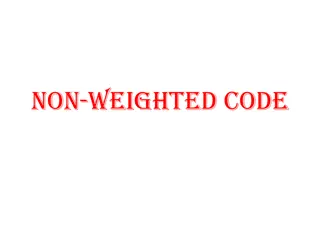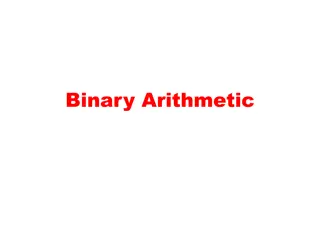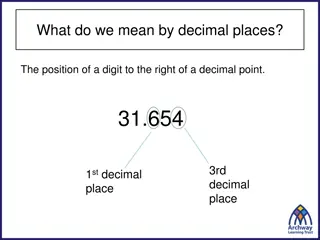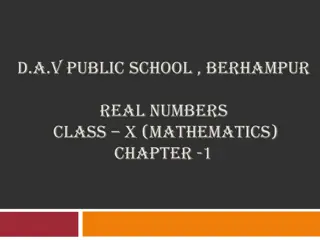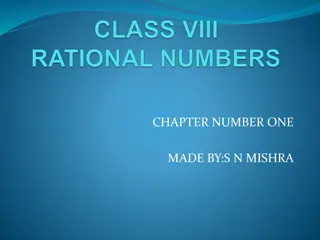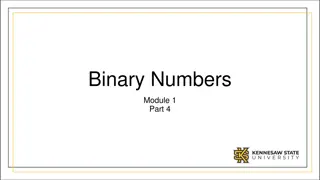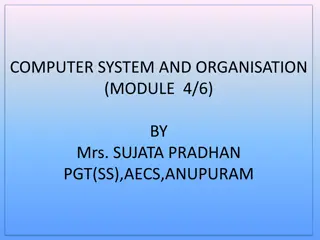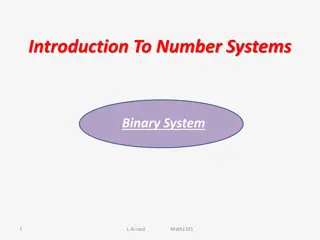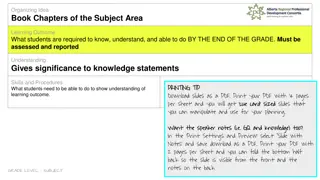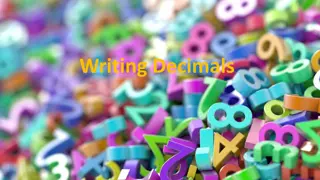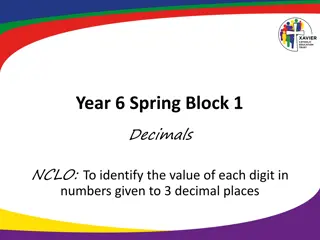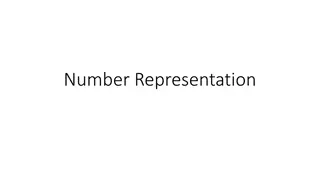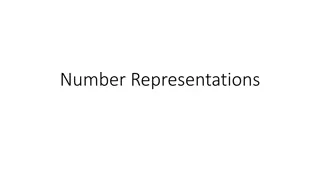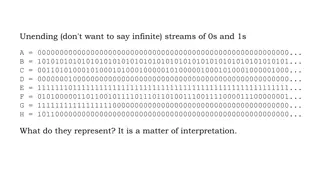Binary and Decimal Numbers Explained
Discover the fascinating world of binary and decimal numbers, their differences, conversions, and how computers store information using binary numbers. Dive into the concepts of base-2 and base-10 systems, understand the relationship between binary and decimal values, and explore examples showcasing the significance of these numerical systems in computing.
Download Presentation

Please find below an Image/Link to download the presentation.
The content on the website is provided AS IS for your information and personal use only. It may not be sold, licensed, or shared on other websites without obtaining consent from the author.If you encounter any issues during the download, it is possible that the publisher has removed the file from their server.
You are allowed to download the files provided on this website for personal or commercial use, subject to the condition that they are used lawfully. All files are the property of their respective owners.
The content on the website is provided AS IS for your information and personal use only. It may not be sold, licensed, or shared on other websites without obtaining consent from the author.
E N D
Presentation Transcript
A binary number is a number that includes only ones and zeroes. The number could be of any length The following are all examples of binary numbers 0 1 10 01 111000 10101 0101010 1011110101 0110101110 000111 Another name for binary is base-2 (pronounced "base two") 2
The numbers that we are used to seeing are called decimal numbers. decimal numbers consist of the digits from 0 (zero) through 9. The following are examples of decimal #'rs 3 15 890 76 32423234 53 Another name for decimal numbers are base-10 (pronounced "base ten") numbers. 3
Every Binary number has a corresponding Decimal value (and vice versa) Examples: Binary Number 1 10 11 1010111 Decimal Equivalent 1 2 3 87 4
Even though they look exactly the same, the value of the binary number, 101, is different from the value of the decimal number, 101. The value of the binary number, 101, is equal to the decimal number five (i.e. 5) The value of the decimal number, 101, is equal to one hundred and one When you see a number that consists of only ones and zeroes, you must be told if it is a binary number or a decimal number. 5
All information that is processed by computers is converted in one way or another into a sequence of numbers. This includes numeric information textual information and Pictures Therefore, if we can derive a way to store and retrieve numbers electronically this method can be used by computers to store and retrieve any type of information. 7
Computers Store ALL information using Binary Numbers Computers use binary numbers in different ways to store different types of information. Common types of information that are stored by computers are : Whole numbers (i.e. Integers). Examples: 8 97 -732 0 -5 etc Numbers with decimal points. Examples: 3.5 -1.234 0.765 999.001 etc Textual information (including letters, symbols and digits) Keep reading 9
Each position for a binary number has a value. For each digit, m`ultiply the digit by its position value Add up all of the products to get the final result The decimal value of binary 101 is computed below: posi ti on val ues ad d these up 4 4 2 2 1 1 -------------------------------------- -------------------------------------- 1 1 0 0 1 1 bi nar y # 1 X 4 1 X 4 0 X 2 0 X 2 1 X 1 1 X 1 = 1 = 1 = 0 = 0 = 4 = 4 ---- ---- 5 5 di gi t X posi ti on val ue r esul t 11
In general, the "position values" in a binary number are the powers of two. The first position value is 20 , i.e. one The 2nd position value is 21 , i.e. two The 2nd position value is 22 , i.e. four The 2nd position value is 23 , i.e. eight The 2nd position value is 24 , i.e. sixteen etc. 12
The value of binary 01100001 is decimal 105. This is worked out below: 128 128 --------------------------------------------------------------- --------------------------------------------------------------- 0 0 1 1 1 1 0 0 1 1 1 X 8 1 X 8 0 X 16 0 X 16 1 X 32 1 X 32 1 X 64 1 X 64 0 X 128 0 X 128 64 64 32 32 16 16 8 8 4 4 2 2 1 1 0 0 0 X 4 0 X 4 0 0 0 X 2 0 X 2 1 1 1 X 1 1 X 1 Answer: Answer: 105 = 1 = 1 = 0 = 0 = 0 = 0 = 8 = 8 = 0 = 0 = 32 = 32 = 64 = 64 = 0 = 0 ---- ---- 105 13
The value of binary 10011100 is decimal 156. This is worked out below: 128 128 --------------------------------------------------------------- --------------------------------------------------------------- 1 1 0 0 0 0 1 1 1 1 1 X 8 1 X 8 1 X 16 1 X 16 0 X 32 0 X 32 0 X 64 0 X 64 1 X 128 1 X 128 64 64 32 32 16 16 8 8 4 4 2 2 1 1 1 1 1 X 4 1 X 4 0 0 0 X 2 0 X 2 0 0 0 X 1 0 X 1 Answer: Answer: 156 = 0 = 0 = 0 = 0 = 4 = 4 = 8 = 8 = 16 = 16 = 0 = 0 = 0 = 0 = 128 = 128 ---- ---- 156 14
The following are some terms that are used in the computer field Each digit of a binary number is called a bit. A binary number with eight bits (i.e. digits) is called a byte. 15
There are two different binary numbers with one bit: 0 1 There are four different binary numbers with two bits: 00 (i.e. decimal 0) 01 (i.e. decimal 1) 10 (i.e. decimal 2) 11 (i.e. decimal 3) 16
There are 8 different binary numbers with 3 bits: 000 001 010 011 100 101 110 111 (i.e. decimal 0) (i.e. decimal 1) (i.e. decimal 2) (i.e. decimal 3) (i.e. decimal 4) (i.e. decimal 5) (i.e. decimal 6) (i.e. decimal 7) 17
For n bits there are 2n different binary numbers: # of bits 1 bit: 2 bits: 3 bits: 4 bits: 5 bits: 6 bits: 7 bits: 8 bits: 9 bits: 10 bits: etc. # of different binary numbers 21 = 2 22 = 4 23 = 8 24 = 16 25 = 32 26 = 64 27 = 128 28 = 256 29 = 512 210 = 1024 18
The smallest value for a binary number of any number of bits is zero. This is the case when all bits are zero. 19
The smallest value for a binary number with any number of bits is zero (i.e. when all the bits are zeros) # of bits smallest binary # decimal value 1 bit: 2 bits: 3 bits: 4 bits: 5 bits: 6 bits: 7 bits: 8 bits: etc. 0 00 000 0000 00000 000000 0000000 00000000 0 0 0 0 0 0 0 0 20
The largest value for a binary number with a specific number of bits (i.e. digits) is when all of the bits are one. General rule: for a binary number with n bits, the largest possible value is : 2n - 1 21
The following are the largest values for binary numbers with a specific number of bits: # of bits largest binary # decimal value 1 bit: 2 bits: 3 bits: 4 bits: 5 bits: 6 bits: 7 bits: 8 bits: etc. 1 11 111 1111 11111 111111 1111111 11111111 1 3 7 15 31 63 127 255 22
The prefix "bi" means "two" in Latin Binary derives its name from the fact that the digits in a "Binary" number can only have two possible values, 0 or 1 It is also called "base-2" based on the fact that the column values are the powers of 2. (i.e. 202122232425 etc. ) 23


